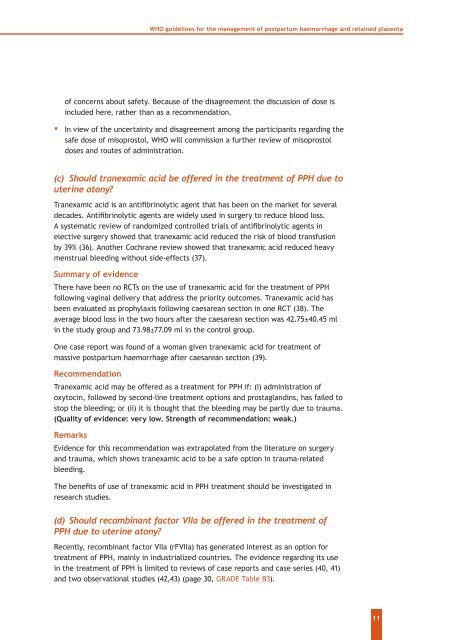WHO guidelines for the management of postpartum haemorrhage ...
WHO guidelines for the management of postpartum haemorrhage ...
WHO guidelines for the management of postpartum haemorrhage ...
You also want an ePaper? Increase the reach of your titles
YUMPU automatically turns print PDFs into web optimized ePapers that Google loves.
<strong>WHO</strong> <strong>guidelines</strong> <strong>for</strong> <strong>the</strong> <strong>management</strong> <strong>of</strong> <strong>postpartum</strong> <strong>haemorrhage</strong> and retained placenta<br />
<strong>of</strong> concerns about safety. Because <strong>of</strong> <strong>the</strong> disagreement <strong>the</strong> discussion <strong>of</strong> dose is<br />
included here, ra<strong>the</strong>r than as a recommendation.<br />
▪ In view <strong>of</strong> <strong>the</strong> uncertainty and disagreement among <strong>the</strong> participants regarding <strong>the</strong><br />
safe dose <strong>of</strong> misoprostol, <strong>WHO</strong> will commission a fur<strong>the</strong>r review <strong>of</strong> misoprostol<br />
doses and routes <strong>of</strong> administration.<br />
(c) Should tranexamic acid be <strong>of</strong>fered in <strong>the</strong> treatment <strong>of</strong> PPH due to<br />
uterine atony?<br />
Tranexamic acid is an antifibrinolytic agent that has been on <strong>the</strong> market <strong>for</strong> several<br />
decades. Antifibrinolytic agents are widely used in surgery to reduce blood loss.<br />
A systematic review <strong>of</strong> randomized controlled trials <strong>of</strong> antifibrinolytic agents in<br />
elective surgery showed that tranexamic acid reduced <strong>the</strong> risk <strong>of</strong> blood transfusion<br />
by 39% (36). Ano<strong>the</strong>r Cochrane review showed that tranexamic acid reduced heavy<br />
menstrual bleeding without side-effects (37).<br />
Summary <strong>of</strong> evidence<br />
There have been no RCTs on <strong>the</strong> use <strong>of</strong> tranexamic acid <strong>for</strong> <strong>the</strong> treatment <strong>of</strong> PPH<br />
following vaginal delivery that address <strong>the</strong> priority outcomes. Tranexamic acid has<br />
been evaluated as prophylaxis following caesarean section in one RCT (38). The<br />
average blood loss in <strong>the</strong> two hours after <strong>the</strong> caesarean section was 42.75±40.45 ml<br />
in <strong>the</strong> study group and 73.98±77.09 ml in <strong>the</strong> control group.<br />
One case report was found <strong>of</strong> a woman given tranexamic acid <strong>for</strong> treatment <strong>of</strong><br />
massive <strong>postpartum</strong> <strong>haemorrhage</strong> after caesarean section (39).<br />
Recommendation<br />
Tranexamic acid may be <strong>of</strong>fered as a treatment <strong>for</strong> PPH if: (i) administration <strong>of</strong><br />
oxytocin, followed by second-line treatment options and prostaglandins, has failed to<br />
stop <strong>the</strong> bleeding; or (ii) it is thought that <strong>the</strong> bleeding may be partly due to trauma.<br />
(Quality <strong>of</strong> evidence: very low. Strength <strong>of</strong> recommendation: weak.)<br />
Remarks<br />
Evidence <strong>for</strong> this recommendation was extrapolated from <strong>the</strong> literature on surgery<br />
and trauma, which shows tranexamic acid to be a safe option in trauma-related<br />
bleeding.<br />
The benefits <strong>of</strong> use <strong>of</strong> tranexamic acid in PPH treatment should be investigated in<br />
research studies.<br />
(d) Should recombinant factor VIIa be <strong>of</strong>fered in <strong>the</strong> treatment <strong>of</strong><br />
PPH due to uterine atony?<br />
Recently, recombinant factor VIIa (rFVIIa) has generated interest as an option <strong>for</strong><br />
treatment <strong>of</strong> PPH, mainly in industrialized countries. The evidence regarding its use<br />
in <strong>the</strong> treatment <strong>of</strong> PPH is limited to reviews <strong>of</strong> case reports and case series (40, 41)<br />
and two observational studies (42,43) (page 30, GRADE Table B3).<br />
11
















